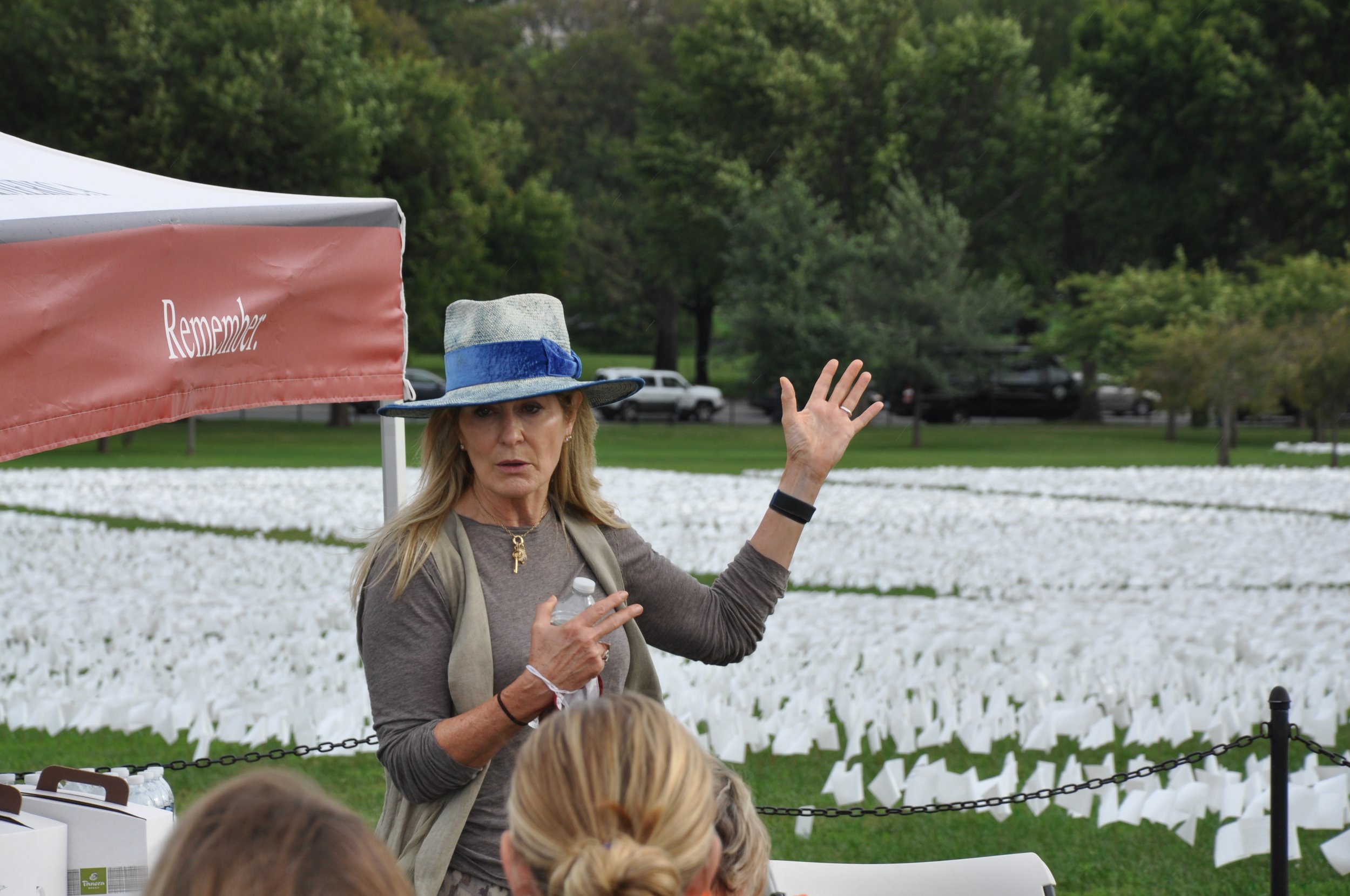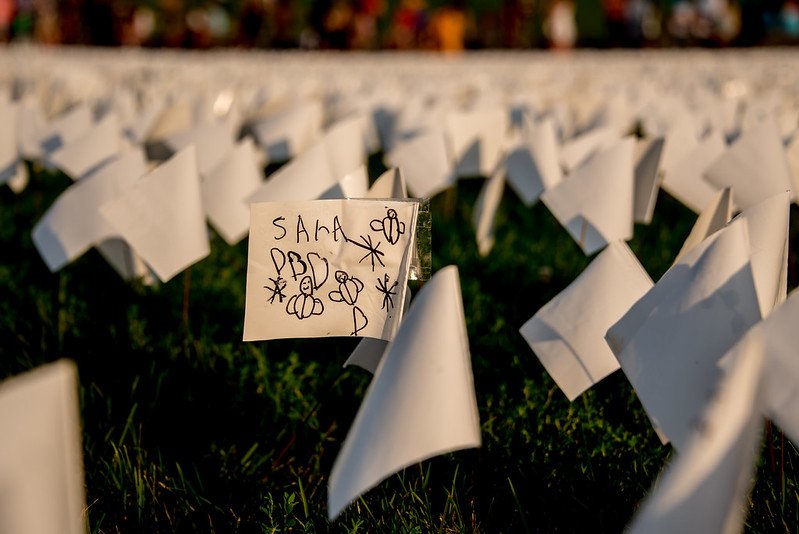One Year Later: Reflections on "In America: Remember” on the National Mall with Artist Suzanne Firstenberg
One Year Later: Reflections on "In America: Remember” on the National Mall with Artist Suzanne Firstenberg
The Trust for the National Mall recently sat down with artist Suzanne Firstenberg to reflect on her powerful and emotional exhibition, “In America: Remember,” one year after its installation on the National Mall. From September 17 to October 3, 2021, over 700,000 white flags were planted on the grounds of the Washington Monument, across from the White House ellipse, to memorialize the American lives lost to the COVID-19 pandemic. With the help of many crucial volunteers, Firstenberg collaborated with the Trust for the National Mall and the National Park Service to implement the sweeping sea of white flags, which continued to grow to keep pace with the lives lost from the pandemic. ”In America: Remember” was a moving temporary art installation that allowed Americans and visitors the space to heal, remember, and reflect with loved ones—as well as bring together strangers to experience shared grief and healing – on the National Mall.
The Trust for the National Mall is currently working—through the generosity of the Mellon Foundation —to bring a series of special commemorative works, performances and exhibitions to the National Mall as part of an innovative project titled Beyond Granite. We spoke with Suzanne about her reflections and takeaways from her powerful exhibit on the National Mall and how it might inform future commemorative installations on the National Mall, including Beyond Granite. Beyond Granite will bring important works of creative expression to the commemorative landscape and create a more inclusive, equitable and representative process for commemoration on the National Mall—and beyond.
Below is our interview with Suzanne, which took place in September 2022, shortly after the one-year anniversary of the opening of “In America: Remember.” Some responses have been edited for length and/or clarity.
What made you choose the National Mall as the stage for a large-scale project like this, and what did it mean to have it just steps away from other iconic structures like the Washington Monument and President’s Park near the White House?
SF: The National Mall was the only place that this really could have gone. I conceptualize the National Mall as not just the space between these important monuments and important buildings — such as the White House and the Capitol — but really, it is the one place where American voices can be heard. The National Mall has become a critical means of people being heard and having our voices make it out there into the ears of others. Its role has become much more important than the Founding Fathers probably ever envisioned.
“In America: Remember” was art for the nation. It was a way to speak truth to the horrific loss of life. It was where we transcended differences and became one in our shared grief.
What was the difference in the tenor and the public response to the installation on the National Mall versus the previous installation at RFK Stadium? (“In America: Remember” was first on display near the DC Armory and RFK Stadium in 2020)
SF: The two installations were very different in tenor. Most visitors to the RFK exhibition sought it out. They had learned of it through grief groups, word-of-mouth or through the local press. On the National Mall, we had many passersby who became entranced by what all those flags represented. And then they were struck by the magnitude of what that represented. We were there on the greatest stage in America. That was one of the most important parts of the art — bringing it to the people.
“The National Mall has become a critical means of people being heard and having our voices make it out there into the ears of others. Its role has become much more important than the Founding Fathers probably ever envisioned.”
Photo by Angela Napili
What is the value of special commemorative art installations and temporary works of art, like the one that you created on the National Mall? What emotional connections or new perspectives is the public able to engage with on the National Mall through special commemorative art installations?
SF: The National Mall is one of the few spaces left where we can all be one.
The National Mall allows us access to other socioeconomic groups, other racial groups, as well as people from other states and countries. That makes it a potent location for introducing new perspectives or emotional connections. It gives us a place where we can all just be Americans. That’s what makes the National Mall the perfect palette to be able to speak truth in these times. When other forms and places of communication just aren't reaching people, the National Mall reaches people.
From conversations with people or passersby, what kind of response did this installation garner during the time that it was on display on the National Mall?
SF: I think that the vastness of the art stopped people in their tracks and made them realize that this was an important message. It was so vast, beautiful and moving that it really spoke emotionally to people, whether or not they had lost a loved one. Many of the people who lost loved ones said, ‘Wow, I didn't realize I had so much company. I thought I was mourning alone.’ It gave them solace because they realized that the grief that they felt was magnified hundreds of times in the hearts and families of others. People had suggested to me that I should use different colors of flags for different groups of people. But it was so important that the flags were of equal size, the same color, and showed the same dignity and respect for individuals lost.
Now that we are one year since the debut of this work, how has this memorial continued to resonate with people and have long-term ripple effects on the public who engaged with the National Mall through this special installation?
SF: People have told me that whenever they go to the Mall, they still see the flags. They still remember the flags. They remember the sound of all those flags fluttering in the wind. They remember the sunlight glistening off of the surfaces of the flags. And they remember the overwhelming feeling that they had. Being able to understand such an incomprehensible number [of deaths] is important. To have a visual means of remembering that and understanding that is critical. It helps explain why this likely will be an image that carries through history to illustrate the stories of pandemic.
The beauty of public art is that it gives an excuse to talk to strangers. In the opening ceremony [of “In America”], I told the audience that I hoped over the course of the [installation] that ‘you will have the chance to talk with strangers.’ We wouldn't go up to a stranger in the grocery store or in a movie theater and start talking with them. We wouldn't know what commonality we had. But [with] “In America,” people were very understanding that they shared shock, surprise, and grief. It gave people a chance to come together and talk to strangers. I am most gratified by the stories that continue to emanate from that art about people who met each other in the flags. And it has continued to create friendships since.
“They still remember the flags. They remember the sound of all those flags fluttering in the wind. They remember the sunlight glistening off of the surfaces of the flags.”
Photo by Angela Napili
How do you approach art installations like “In America” that are dependent on real-time developments and day-to-day data?
SF: That was one of the saddest things about creating this art. Each day, I changed the number on a large sign to reflect the number who had died the day prior. Planting additional flags to add to that art was really sobering. On average, I added 2,000 flags a day. The art started at 666,000 flags on the National Mall. And within the course of 17 days, it increased to over 700,001 flags. It grew tremendously over time.
What do you want to see in future temporary, commemorative installations on this incredible venue—the National Mall?
SF: I think there’s no better location to speak to the nation than on the National Mall. This is a space for all of us. It’s all of ours. It transcends everything that divides us. I would like to see art that helps unify us. I would like to see art that gives us hope and makes us understand that we’re all connected. My art was about humanity and the expression of it. The National Mall is the perfect place for those kinds of messages. I think it can be host to some phenomenal art in the future — art that can move the needle and bring us back together.
“I think it can be host to some phenomenal art in the future — art that can move the needle and bring us back together.”
Photo courtesy of Suzanne Firstenberg




